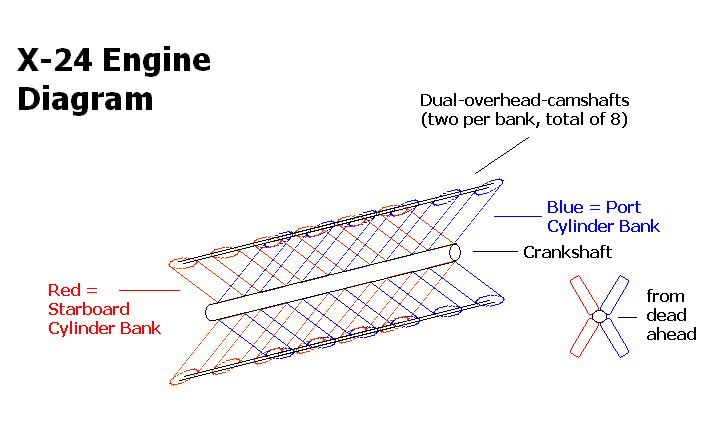 | ||
The X24 is one of the few configurations of X-type engines known to have been produced. The design consists of a pairing of V12s joined to a common crankshaft, which is lighter than the similar W-block or H-block designs, which require two crankshafts. However, none of the existing X24 engines was particularly successful; few saw service, and their production lifetimes were very limited. Postwar developments of the turbojet and turbofan engines apparently obviated the need for large aircraft engines of this type.
Designs were developed by two of the Axis Powers, Italy and Germany. The German engine was the Daimler-Benz DB 604, intended for use in the Bomber B program. Development was cancelled as the strategic situation changed for Germany, and as the gas turbine engine made its debut. Italy's Isotta-Fraschini developed the Zeta R.C. 24/60 for the Caproni F6 fighter, but Italy's surrender ended development.
In the United Kingdom, Rolls-Royce planned on producing two engines during the war, the 750 hp V12 Rolls-Royce Peregrine, and the X24 1,750 hp Rolls-Royce Vulture based on the Peregrine. In production the Peregrine proved troublesome, and bolting two together to produce the Vulture only compounded the problems. Development work on both ended in 1941 as Rolls concentrated on an interim design intended to fill in the power gap between the two, which had developed into the 1,100 hp Rolls-Royce Merlin.
In the Soviet Union a huge (its width, according to different sources, was 1.47m or 1.95m) Dobrotvorskiy MB-100 was developed in 1942 and mounted on a Yermolayev Yer-2 bomber. The construction was based on duplication of V12 VK-105. It wasn't reliable and consumed almost 500 kg petrol per hour, weighted (in dry condition) 1250 kg. Its power was 2200 hp (nominal) in 1942 and up to 2400/3200 hp (nominal/take-off) in 1945. It has never seen service.
